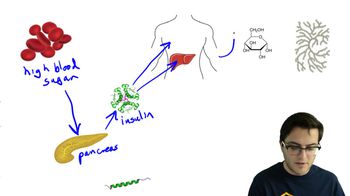Table of contents
- 1. Introduction to Biology2h 42m
- 2. Chemistry3h 37m
- 3. Water1h 26m
- 4. Biomolecules2h 23m
- 5. Cell Components2h 26m
- 6. The Membrane2h 31m
- 7. Energy and Metabolism2h 0m
- 8. Respiration2h 40m
- 9. Photosynthesis2h 49m
- 10. Cell Signaling59m
- 11. Cell Division2h 47m
- 12. Meiosis2h 0m
- 13. Mendelian Genetics4h 44m
- Introduction to Mendel's Experiments7m
- Genotype vs. Phenotype17m
- Punnett Squares13m
- Mendel's Experiments26m
- Mendel's Laws18m
- Monohybrid Crosses19m
- Test Crosses14m
- Dihybrid Crosses20m
- Punnett Square Probability26m
- Incomplete Dominance vs. Codominance20m
- Epistasis7m
- Non-Mendelian Genetics12m
- Pedigrees6m
- Autosomal Inheritance21m
- Sex-Linked Inheritance43m
- X-Inactivation9m
- 14. DNA Synthesis2h 27m
- 15. Gene Expression3h 6m
- 16. Regulation of Expression3h 31m
- Introduction to Regulation of Gene Expression13m
- Prokaryotic Gene Regulation via Operons27m
- The Lac Operon21m
- Glucose's Impact on Lac Operon25m
- The Trp Operon20m
- Review of the Lac Operon & Trp Operon11m
- Introduction to Eukaryotic Gene Regulation9m
- Eukaryotic Chromatin Modifications16m
- Eukaryotic Transcriptional Control22m
- Eukaryotic Post-Transcriptional Regulation28m
- Eukaryotic Post-Translational Regulation13m
- 17. Viruses37m
- 18. Biotechnology2h 58m
- 19. Genomics17m
- 20. Development1h 5m
- 21. Evolution3h 1m
- 22. Evolution of Populations3h 53m
- 23. Speciation1h 37m
- 24. History of Life on Earth2h 6m
- 25. Phylogeny2h 31m
- 26. Prokaryotes4h 59m
- 27. Protists1h 12m
- 28. Plants1h 22m
- 29. Fungi36m
- 30. Overview of Animals34m
- 31. Invertebrates1h 2m
- 32. Vertebrates50m
- 33. Plant Anatomy1h 3m
- 34. Vascular Plant Transport1h 2m
- 35. Soil37m
- 36. Plant Reproduction47m
- 37. Plant Sensation and Response1h 9m
- 38. Animal Form and Function1h 19m
- 39. Digestive System1h 10m
- 40. Circulatory System1h 49m
- 41. Immune System1h 12m
- 42. Osmoregulation and Excretion50m
- 43. Endocrine System1h 4m
- 44. Animal Reproduction1h 2m
- 45. Nervous System1h 55m
- 46. Sensory Systems46m
- 47. Muscle Systems23m
- 48. Ecology3h 11m
- Introduction to Ecology20m
- Biogeography14m
- Earth's Climate Patterns50m
- Introduction to Terrestrial Biomes10m
- Terrestrial Biomes: Near Equator13m
- Terrestrial Biomes: Temperate Regions10m
- Terrestrial Biomes: Northern Regions15m
- Introduction to Aquatic Biomes27m
- Freshwater Aquatic Biomes14m
- Marine Aquatic Biomes13m
- 49. Animal Behavior28m
- 50. Population Ecology3h 41m
- Introduction to Population Ecology28m
- Population Sampling Methods23m
- Life History12m
- Population Demography17m
- Factors Limiting Population Growth14m
- Introduction to Population Growth Models22m
- Linear Population Growth6m
- Exponential Population Growth29m
- Logistic Population Growth32m
- r/K Selection10m
- The Human Population22m
- 51. Community Ecology2h 46m
- Introduction to Community Ecology2m
- Introduction to Community Interactions9m
- Community Interactions: Competition (-/-)38m
- Community Interactions: Exploitation (+/-)23m
- Community Interactions: Mutualism (+/+) & Commensalism (+/0)9m
- Community Structure35m
- Community Dynamics26m
- Geographic Impact on Communities21m
- 52. Ecosystems2h 36m
- 53. Conservation Biology24m
40. Circulatory System
Gas Exchange
Problem 1
Textbook Question
Complete the following concept map to review some of the concepts of gas exchange.

 Verified step by step guidance
Verified step by step guidance1
Step 1: Identify the requirements for gas exchange. Gas exchange requires a moist, thin surface (a) to facilitate the exchange of gases like oxygen (O₂) and carbon dioxide (CO₂). Oxygen is needed for cellular respiration, while carbon dioxide is a waste product of this process.
Step 2: Recognize the role of transport mechanisms. Gas exchange often relies on (b) the circulatory system to transport gases between the lungs and tissue cells (c).
Step 3: Understand the role of red blood cells. Red blood cells contain (d) hemoglobin, a protein that binds and transports oxygen and helps to buffer the blood by transporting CO₂ (g).
Step 4: Explore ventilation in mammals. Mammals ventilate by (f) breathing, which is regulated by breathing control centers in the brain. This ensures the continuous exchange of gases.
Step 5: Connect the concepts. The process of gas exchange integrates the roles of the respiratory system, circulatory system, and cellular respiration to maintain homeostasis and support life functions.
 Verified video answer for a similar problem:
Verified video answer for a similar problem:This video solution was recommended by our tutors as helpful for the problem above
Video duration:
1mPlay a video:
Was this helpful?
Key Concepts
Here are the essential concepts you must grasp in order to answer the question correctly.
Gas Exchange
Gas exchange is the biological process through which organisms exchange oxygen (O2) and carbon dioxide (CO2) with their environment. This process is essential for cellular respiration, where O2 is utilized for energy production, and CO2 is expelled as a waste product. Effective gas exchange requires a moist and thin membrane to facilitate the diffusion of gases.
Recommended video:
Guided course

Gas Exchange and Breathing
Role of Red Blood Cells
Red blood cells (RBCs) play a crucial role in gas exchange by transporting O2 from the lungs to tissues and carrying CO2 from tissues back to the lungs. They contain hemoglobin, a protein that binds to O2 and CO2, enhancing the efficiency of gas transport in the circulatory system. This binding is vital for maintaining proper oxygen levels in tissues and removing metabolic waste.
Recommended video:
Guided course

Blood Sugar Homeostasis
Breathing Control Centers
Breathing control centers, located in the brainstem, regulate the rate and depth of breathing based on the body's oxygen and carbon dioxide levels. These centers respond to changes in blood chemistry, ensuring that gas exchange meets the metabolic demands of the body. Proper functioning of these centers is essential for maintaining homeostasis and efficient gas exchange.
Recommended video:
Guided course

Gas Exchange and Breathing

 5:55m
5:55mWatch next
Master Gas Exchange and Breathing with a bite sized video explanation from Jason
Start learningRelated Videos
Related Practice
Multiple Choice
Countercurrent flow in the gills of a fish __________.
1290
views
